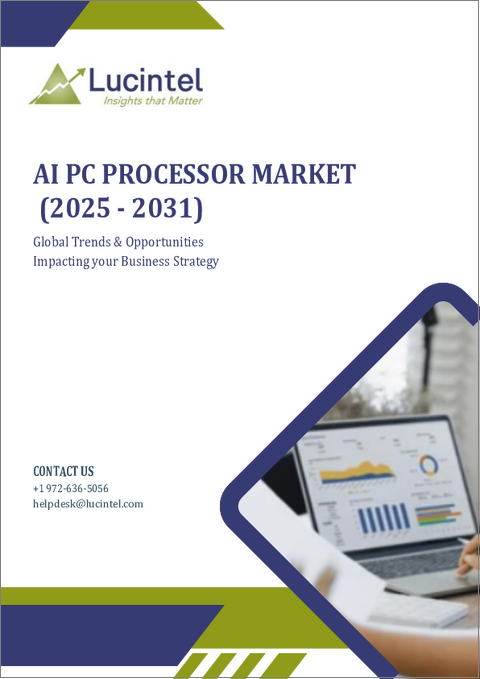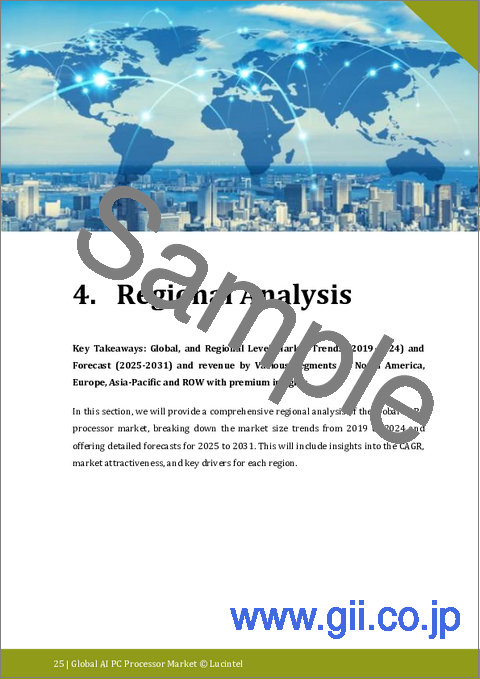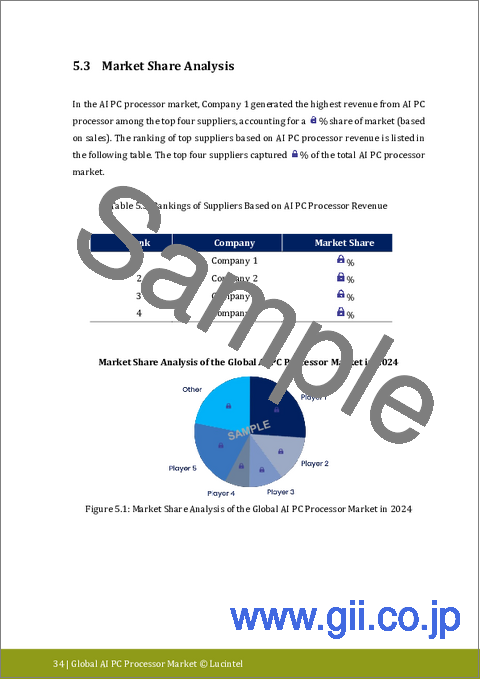|
|
市場調査レポート
商品コード
1680212
AI PCプロセッサ市場レポート:2031年までの動向、予測、競合分析AI PC Processor Market Report: Trends, Forecast and Competitive Analysis to 2031 |
||||||
カスタマイズ可能
適宜更新あり
|
|||||||
| AI PCプロセッサ市場レポート:2031年までの動向、予測、競合分析 |
|
出版日: 2025年03月13日
発行: Lucintel
ページ情報: 英文 150 Pages
納期: 3営業日
|
全表示
- 概要
- 目次
世界のAI PCプロセッサ市場の将来は、デスクトップコンピュータとノートパソコン市場における機会があり、有望視されています。世界のAI PCプロセッサ市場は、2025~2031年にかけてCAGR 6.7%で成長すると予想されます。この市場の主な促進要因は、機械学習やデータ分析などのアプリケーションにおけるAI需要の高まり、強力なAIプロセッサを必要とするクラウドベースのサービスの成長、プロセッサの効率と能力の継続的な改善です。
- Lucintelの予測によると、タイプ別では、統合型NPUセグメントが予測期間中に高い成長を遂げる見込みです。
- 用途別では、デスクトップコンピュータが高い成長を遂げる見込みです。
- 地域別では、アジア太平洋地域が予測期間中に最も高い成長が見込まれます。
AI PCプロセッサ市場の戦略的成長機会
AI PCプロセッサ市場には、さまざまな用途でいくつかの戦略的成長機会があります。これらの機会が技術革新を促進し、市場の可能性を拡大しています。
- データセンターへの拡大:AIプロセッサは、大規模なAIおよび機械学習ワークロードを処理するため、データセンターでの採用が増加しています。この拡大は、クラウドベースのAIサービスやビッグデータ解析の需要拡大を支えています。
- エッジコンピューティングアプリケーションの成長:エッジコンピューティングの台頭により、現場でのデータ処理用に設計されたAIプロセッサに機会が生まれています。この成長は、リアルタイムの分析と意思決定を可能にすることで、自動車、ヘルスケア、製造などの業界に利益をもたらします。
- 家電製品の進歩:AIプロセッサは、スマートフォンやスマートホームデバイスなどの家電製品に統合されつつあります。この進歩により、音声認識、画像処理、パーソナライズされたユーザー体験などの機能が強化されます。
- 自律システム用AIの開発:自動運転車やドローンなど、自律システム用のAIプロセッサの開発には大きなチャンスがあります。これらのプロセッサは、自律型アプリケーションにおけるリアルタイム処理と意思決定に不可欠です。
- AI研究開発への投資:AIプロセッサの研究開発への投資は、イノベーションと差別化の機会をもたらします。最先端の技術やアーキテクチャの開発に注力する企業は、市場シェアを獲得し、業界の進歩を推進することができます。
こうした成長機会は、イノベーションを促進し、用途を拡大することで、AI PCプロセッサ市場を形成しています。データセンター、エッジコンピューティング、家電製品、自律システム、研究開発への注力は、市場の拡大と技術進歩に拍車をかけています。
AI PCプロセッサ市場の促進要因・課題
AI PCプロセッサ市場は、その成長と発展を形作る様々な促進要因・課題の影響を受けています。これらの要因には、技術の進歩、経済状況、規制上の考慮事項などが含まれます。
AI PCプロセッサ市場の促進要因は以下の通りです:
- 技術の進歩:半導体技術とAIアルゴリズムにおける継続的な技術革新が、より強力で効率的なAIプロセッサの開発を促進しています。この進歩は、さまざまな業界におけるAI用途の需要拡大を支えています。
- AI用途の需要増加:ヘルスケア、金融、自動車などの分野におけるAI導入の増加が、高度なAIプロセッサの必要性を高めています。この需要がAIプロセッサ技術への投資と開発を後押ししています。
- クラウドコンピューティングの成長:クラウドコンピューティングサービスの拡大により、データセンターにおけるAIプロセッサの需要が高まっています。この成長は、スケーラブルで効率的なAI処理能力の必要性を裏付けています。
- エッジコンピューティングの台頭:エッジコンピューティングへのシフトにより、エッジでのリアルタイム処理と意思決定が可能なAIプロセッサの需要が高まっています。この動向は、IoT、自律走行車、スマートシティなどへの応用をサポートしています。
- AI研究開発への投資:AI研究開発への投資の増加は、AIプロセッサのイノベーションを促進しています。各社は、進化するAIのニーズに対応し、競争上の優位性を維持するために、新しい技術やアーキテクチャを開発しています。
AI PCプロセッサ市場における課題は以下の通りです:
- 高い開発コスト:高度なAIプロセッサの開発には、研究、設計、製造に関連する多額のコストがかかります。こうした高コストは一部の企業にとって障壁となり、市場参入を制限する可能性があります。
- 急速な技術革新:AIや半導体業界では技術進歩のペースが速いため、製品ライフサイクルが短くなり、継続的な技術革新が必要となります。企業は競争力を維持するために、こうした変化に対応していかなければなりません。
- サプライチェーンの混乱:AIプロセッサ市場は、重要な部品や材料の不足など、世界的なサプライチェーンの混乱の影響を受けます。こうした混乱は、生産スケジュールやコスト構造に影響を与える可能性があります。
AI PCプロセッサ市場に影響を与える主な促進要因・課題は、市場の成長と発展を形成しています。技術の進歩と需要の増加が進展を促す一方で、高い開発コスト、急速な変化、サプライチェーンの問題が大きな課題となっています。
目次
第1章 エグゼクティブサマリー
第2章 世界のAI PCプロセッサ市場:市場力学
- イントロダクション、背景、分類
- サプライチェーン
- 業界の促進要因と課題
第3章 市場動向と予測分析(2019~2031年)
- マクロ経済動向(2019~2024年)と予測(2025~2031年)
- 世界のAI PCプロセッサ市場の動向(2019~2024年)と予測(2025~2031年)
- 世界のAI PCプロセッサ市場:タイプ別
- 統合型NPU
- 非統合型NPU
- 世界のAI PCプロセッサ市場:用途別
- デスクトップコンピュータ
- ノートパソコン
第4章 地域別の市場動向と予測分析(2019~2031年)
- 世界のAI PCプロセッサ市場:地域別
- 北米のAI PCプロセッサ市場
- 欧州のAI PCプロセッサ市場
- アジア太平洋のAI PCプロセッサ市場
- その他地域のAI PCプロセッサ市場
第5章 競合分析
- 製品ポートフォリオ分析
- 運用統合
- ポーターのファイブフォース分析
第6章 成長機会と戦略分析
- 成長機会分析
- 世界のAI PCプロセッサ市場の成長機会:タイプ別
- 世界のAI PCプロセッサ市場の成長機会:用途別
- 世界のAI PCプロセッサ市場の成長機会:地域別
- 世界のAI PCプロセッサ市場の新たな動向
- 戦略分析
- 新製品開発
- 世界のAI PCプロセッサ市場の容量拡大
- 世界のAI PCプロセッサ市場における合併、買収、合弁事業
- 認証とライセンシング
第7章 主要企業の企業プロファイル
- NVIDIA
- AMD
- Qualcomm
- Apple
- Intel
The future of the global AI PC processor market looks promising with opportunities in the desktop computer and laptop computer markets. The global AI PC processor market is expected to grow with a CAGR of 6.7% from 2025 to 2031. The major drivers for this market are rising demand for AI in applications like machine learning and data analysis, growth in cloud-based services requiring powerful AI processors, and ongoing improvements in processor efficiency and capability.
- Lucintel forecasts that, within the type category, the integrated NPU segment is expected to witness higher growth over the forecast period.
- Within the application category, a desktop computer is expected to witness higher growth.
- In terms of regions, APAC is expected to witness the highest growth over the forecast period.
Gain valuable insights for your business decisions with our comprehensive 150+ page report.
Emerging Trends in the AI PC Processor Market
The AI PC processor market is evolving with several key trends shaping its future. These trends reflect the growing complexity of AI applications and the need for more specialized hardware.
- Increasing Integration of AI and GPU Technologies: AI processors are increasingly incorporating GPU technologies to handle parallel processing and complex AI algorithms more efficiently. This integration improves performance for tasks like deep learning and data analytics.
- Development of Specialized AI Cores: New processors are being designed with specialized AI cores optimized for specific types of AI workloads. These cores enhance performance and efficiency for tasks such as image recognition and natural language processing.
- Growth of Edge AI Processing: There is a shift toward deploying AI processors at the edge, closer to data sources. This trend supports real-time processing and reduces latency, benefiting applications in autonomous vehicles and smart cities.
- Enhanced Focus on Energy Efficiency: As AI processing demands increase, there is a stronger emphasis on developing energy-efficient processors. This focus aims to reduce operational costs and address environmental concerns associated with high-power AI computing.
- Expansion of AI Processor Ecosystems: The market is seeing growth in AI processor ecosystems, including software and development tools. These ecosystems support developers and businesses in creating and optimizing AI applications, facilitating broader adoption.
These trends are reshaping the AI PC processor market by driving innovation and addressing specific needs in AI computing. The focus on efficiency, specialization, and ecosystem support is enabling more advanced and widespread use of AI technologies.
Recent Developments in the AI PC Processor Market
The AI PC processor market is evolving rapidly with new advancements that are enhancing performance and expanding applications. Recent developments include technological breakthroughs and strategic initiatives by key players.
- Development of High-Performance AI Chips: Major tech companies are releasing AI processors with higher performance capabilities, including improved neural network processing units. These chips are designed to handle more complex AI tasks with greater speed and efficiency.
- Introduction of AI-Optimized Architectures: New processor architectures are being introduced that are specifically optimized for AI workloads. These architectures provide better parallel processing and higher throughput, catering to the growing demand for AI applications.
- Advancements in Quantum Computing Integration: Some AI processors are being developed with quantum computing capabilities. This integration aims to enhance computational power and solve problems that are currently beyond the reach of classical computing.
- Increased Focus on AI in Mobile Devices: AI processors are being integrated into mobile devices to support advanced features such as augmented reality and real-time language translation. This trend is driving innovation in mobile technology and user experiences.
- Expansion of AI Processor Ecosystems: Companies are developing comprehensive ecosystems around their AI processors, including software, development kits, and support services. This expansion aims to accelerate the adoption and deployment of AI technologies across various sectors.
These developments are driving significant advancements in the AI PC processor market, enhancing capabilities, and expanding applications. The focus on performance, integration, and ecosystem support is shaping the future of AI technology.
Strategic Growth Opportunities for the AI PC Processor Market
The AI PC processor market offers several strategic growth opportunities across various applications. These opportunities are driving innovation and expanding the market potential.
- Expansion into Data Centers: AI processors are increasingly being adopted in data centers to handle large-scale AI and machine learning workloads. This expansion supports the growing demand for cloud-based AI services and big data analytics.
- Growth in Edge Computing Applications: The rise of edge computing is creating opportunities for AI processors designed for on-site data processing. This growth benefits industries such as automotive, healthcare, and manufacturing by enabling real-time analytics and decision-making.
- Advancement in Consumer Electronics: AI processors are being integrated into consumer electronics like smartphones and smart home devices. This advancement enhances features such as voice recognition, image processing, and personalized user experiences.
- Development of AI for Autonomous Systems: There is a significant opportunity in developing AI processors for autonomous systems, including self-driving cars and drones. These processors are critical for real-time processing and decision-making in autonomous applications.
- Investment in AI Research and Development: Investing in R&D for AI processors presents opportunities for innovation and differentiation. Companies focusing on developing cutting-edge technologies and architectures can capture market share and drive industry advancements.
These growth opportunities are shaping the AI PC processor market by driving innovation and expanding applications. The focus on data centers, edge computing, consumer electronics, autonomous systems, and R&D is fueling market expansion and technological progress.
AI PC Processor Market Driver and Challenges
The AI PC processor market is influenced by various drivers and challenges that shape its growth and development. These factors include technological advancements, economic conditions, and regulatory considerations.
The factors responsible for driving the AI PC processor market include:
- Technological Advancements: Ongoing innovations in semiconductor technology and AI algorithms are driving the development of more powerful and efficient AI processors. This advancement supports the growing demand for AI applications across various industries.
- Increased Demand for AI Applications: The rise in AI adoption across sectors such as healthcare, finance, and automotive is fueling the need for advanced AI processors. This demand drives investment and development in AI processor technologies.
- Growth of Cloud Computing: The expansion of cloud computing services is creating a higher demand for AI processors in data centers. This growth supports the need for scalable and efficient AI processing capabilities.
- Rise of Edge Computing: The shift toward edge computing is driving demand for AI processors capable of real-time processing and decision-making at the edge. This trend supports applications in IoT, autonomous vehicles, and smart cities.
- Investment in AI Research and Development: Increased investment in AI R&D is promoting innovation in AI processors. Companies are developing new technologies and architectures to address evolving AI needs and maintain competitive advantages.
Challenges in the AI PC processor market are:
- High Development Costs: Developing advanced AI processors involves significant costs related to research, design, and manufacturing. These high costs can be a barrier for some companies and limit market entry.
- Rapid Technological Changes: The fast pace of technological advancements in AI and semiconductor industries can lead to shorter product lifecycles and the need for continuous innovation. Companies must keep up with these changes to remain competitive.
- Supply Chain Disruptions: The AI processor market is affected by global supply chain disruptions, including shortages of critical components and materials. These disruptions can impact production schedules and cost structures.
The major drivers and challenges impacting the AI PC processor market are shaping its growth and development. Technological advancements and increasing demand are driving progress, while high development costs, rapid changes, and supply chain issues present significant challenges.
List of AI PC Processor Companies
Companies in the market compete based on product quality offered. Major players in this market focus on expanding their manufacturing facilities, R&D investments, infrastructural development, and leverage integration opportunities across the value chain. Through these strategies, AI PC processor companies cater to increasing demand, ensure competitive effectiveness, develop innovative products & technologies, reduce production costs, and expand their customer base. Some of the AI PC processor companies profiled in this report include-
- NVIDIA
- AMD
- Qualcomm
- Apple
- Intel
AI PC Processor by Segment
The study includes a forecast for the global AI PC processor market by type, application, and region.
AI PC Processor Market by Type [Analysis by Value from 2019 to 2031]:
- Integrated NPU
- No Integrated NPU
AI PC Processor Market by Application [Analysis by Value from 2019 to 2031]:
- Desktop Computer
- Laptop Computer
AI PC Processor Market by Region [Analysis by Value from 2019 to 2031]:
- North America
- Europe
- Asia Pacific
- The Rest of the World
Country Wise Outlook for the AI PC Processor Market
Major players in the market are expanding their operations and forming strategic partnerships to strengthen their positions. The below image highlights recent developments by major AI PC processor producers in key regions: the USA, China, India, Japan, and Germany.
- United States: The U.S. has seen major advancements with companies like NVIDIA and Intel releasing new AI-centric processors, enhancing capabilities for data centers and AI applications. These developments focus on integrating more powerful GPUs and specialized AI cores to handle complex workloads.
- China: China is rapidly advancing with local firms such as Huawei and Baidu launching new AI processors. These processors are designed to boost AI performance for various applications, including cloud computing and smart devices, and reduce dependency on foreign technology.
- Germany: Germany is focusing on developing AI processors that cater to industrial applications. German companies are integrating AI processors with edge computing technologies to improve manufacturing efficiency and automation, emphasizing precision and real-time processing.
- India: India is making strides with startups and tech giants developing AI processors to support its growing tech ecosystem. Recent developments include processors designed for mobile and embedded applications, aiming to enhance local AI capabilities and support smart city initiatives.
- Japan: Japan is advancing its AI processor technology with a focus on robotics and consumer electronics. Japanese firms are working on processors that offer high energy efficiency and integration with AI-driven robotics for applications in manufacturing and daily life.
Features of the Global AI PC Processor Market
Market Size Estimates: AI PC processor market size estimation in terms of value ($B).
Trend and Forecast Analysis: Market trends (2019 to 2024) and forecasts (2025 to 2031) by various segments and regions.
Segmentation Analysis: AI PC processor market size by type, application, and region in terms of value ($B).
Regional Analysis: AI PC processor market breakdown by North America, Europe, Asia Pacific, and Rest of the World.
Growth Opportunities: Analysis of growth opportunities in different types, applications, and regions for the AI PC processor market.
Strategic Analysis: This includes M&A, new product development, and the competitive landscape of the AI PC processor market.
Analysis of competitive intensity of the industry based on Porter's Five Forces model.
If you are looking to expand your business in this market or adjacent markets, then contact us. We have done hundreds of strategic consulting projects in market entry, opportunity screening, due diligence, supply chain analysis, M&A, and more.
This report answers the following 11 key questions:
- Q.1. What are some of the most promising, high-growth opportunities for the AI PC processor market by type (integrated NPU and no integrated NPU), application (desktop computer and laptop computer), and region (North America, Europe, Asia Pacific, and the Rest of the World)?
- Q.2. Which segments will grow at a faster pace and why?
- Q.3. Which region will grow at a faster pace and why?
- Q.4. What are the key factors affecting market dynamics? What are the key challenges and business risks in this market?
- Q.5. What are the business risks and competitive threats in this market?
- Q.6. What are the emerging trends in this market and the reasons behind them?
- Q.7. What are some of the changing demands of customers in the market?
- Q.8. What are the new developments in the market? Which companies are leading these developments?
- Q.9. Who are the major players in this market? What strategic initiatives are key players pursuing for business growth?
- Q.10. What are some of the competing products in this market and how big of a threat do they pose for loss of market share by material or product substitution?
- Q.11. What M&A activity has occurred in the last 5 years and what has its impact been on the industry?
Table of Contents
1. Executive Summary
2. Global AI PC Processor Market : Market Dynamics
- 2.1: Introduction, Background, and Classifications
- 2.2: Supply Chain
- 2.3: Industry Drivers and Challenges
3. Market Trends and Forecast Analysis from 2019 to 2031
- 3.1. Macroeconomic Trends (2019-2024) and Forecast (2025-2031)
- 3.2. Global AI PC Processor Market Trends (2019-2024) and Forecast (2025-2031)
- 3.3: Global AI PC Processor Market by Type
- 3.3.1: Integrated NPU
- 3.3.2: No Integrated NPU
- 3.4: Global AI PC Processor Market by Application
- 3.4.1: Desktop Computer
- 3.4.2: Laptop Computer
4. Market Trends and Forecast Analysis by Region from 2019 to 2031
- 4.1: Global AI PC Processor Market by Region
- 4.2: North American AI PC Processor Market
- 4.2.1: North American AI PC Processor Market by Type: Integrated NPU and No Integrated NPU
- 4.2.2: North American AI PC Processor Market by Application: Desktop Computer and Laptop Computer
- 4.3: European AI PC Processor Market
- 4.3.1: European AI PC Processor Market by Type: Integrated NPU and No Integrated NPU
- 4.3.2: European AI PC Processor Market by Application: Desktop Computer and Laptop Computer
- 4.4: APAC AI PC Processor Market
- 4.4.1: APAC AI PC Processor Market by Type: Integrated NPU and No Integrated NPU
- 4.4.2: APAC AI PC Processor Market by Application: Desktop Computer and Laptop Computer
- 4.5: ROW AI PC Processor Market
- 4.5.1: ROW AI PC Processor Market by Type: Integrated NPU and No Integrated NPU
- 4.5.2: ROW AI PC Processor Market by Application: Desktop Computer and Laptop Computer
5. Competitor Analysis
- 5.1: Product Portfolio Analysis
- 5.2: Operational Integration
- 5.3: Porter's Five Forces Analysis
6. Growth Opportunities and Strategic Analysis
- 6.1: Growth Opportunity Analysis
- 6.1.1: Growth Opportunities for the Global AI PC Processor Market by Type
- 6.1.2: Growth Opportunities for the Global AI PC Processor Market by Application
- 6.1.3: Growth Opportunities for the Global AI PC Processor Market by Region
- 6.2: Emerging Trends in the Global AI PC Processor Market
- 6.3: Strategic Analysis
- 6.3.1: New Product Development
- 6.3.2: Capacity Expansion of the Global AI PC Processor Market
- 6.3.3: Mergers, Acquisitions, and Joint Ventures in the Global AI PC Processor Market
- 6.3.4: Certification and Licensing
7. Company Profiles of Leading Players
- 7.1: NVIDIA
- 7.2: AMD
- 7.3: Qualcomm
- 7.4: Apple
- 7.5: Intel




